Sizzling Success: Stir-Frying Protein Perfection
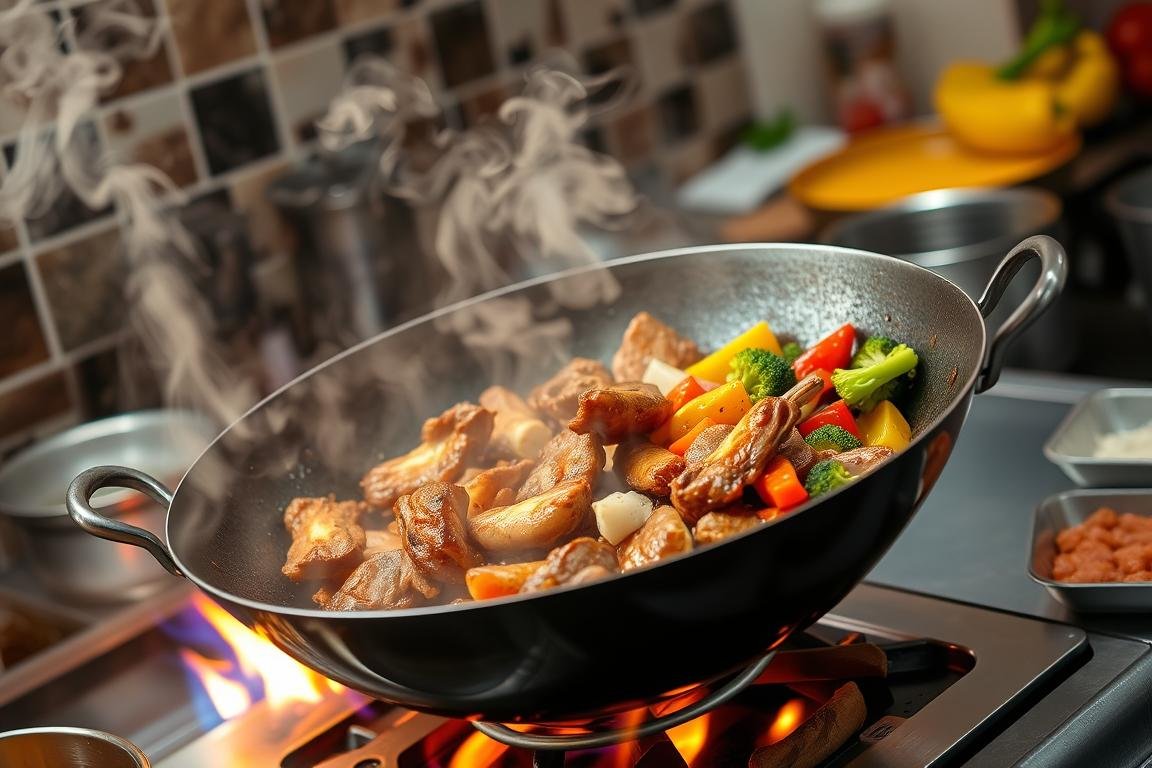
Have you wondered about the magic of stir-frying? It blends flavors and textures fast. The secret to sizzling meat and seafood stir-fries is here. Let’s explore how stir-frying has become essential in Asian cooking and healthy meals.
Stir-frying started thousands of years ago in China, during the Eastern Zhou period. The term “stir-fry” was coined in the mid-20th century. It has since made our meals healthier and tastier. We’ll look into how high heat cooks proteins perfectly.
Key Takeaways
- Discover the historical journey from ancient China to your kitchen that brought stir-frying to the forefront of meal preparation.
- Learn why the “hot wok, cold oil” method is pivotal for achieving the coveted sear on proteins.
- Understand how wok hei, the breath of the wok, infuses a unique smoky taste into your stir-fries.
- Explore the reasons behind the design and material of woks and how they contribute to the dynamic cooking process.
- Unwrap the statistics and facts that define stir-frying not just as a method, but as a tradition that offers quick, well-balanced, and delightful meals.
The Historical Wok: Unearthing the Roots of Stir-Frying
Have you ever used a wok for cooking? It has a long history that you might not know. The wok is deeply rooted in ancient cuisine. It’s tied to Chinese culinary methods. We’ll explore how wok techniques became essential worldwide.
Tracing Back to Ancient China
Back in the Eastern Zhou period, woks were used differently. They were for drying grain, not for cooking. By the Ming Dynasty, the wok was key for quick cooking. This was a big change. It led to stir-frying, saving fuel and time.
The Evolution of Stir-Frying Techniques
Stir-frying has a long history. It was shaped by Chinese dynasties and their foods. The Han dynasty grew different crops and used many seasonings. This influenced wok cooking a lot. Canals connected regions, spreading new cooking ideas.
Adaptation and Adoption in Western Kitchens
When Chinese immigrants came to the West in the 19th century, they brought the wok. It was a piece of their culture. The wok is special for how it cooks food. It gives a unique flavor and texture called wok hei. This method became popular in America. It blends tradition with today’s cooking.
Stir-Frying Meat and Seafood: Achieving Textural Nirvana
Starting to cook stir-frying meat and seafood can make your food taste and feel amazing. Using high heat and marinating makes your dishes crispy yet juicy. It’s like unlocking a secret to great cooking.
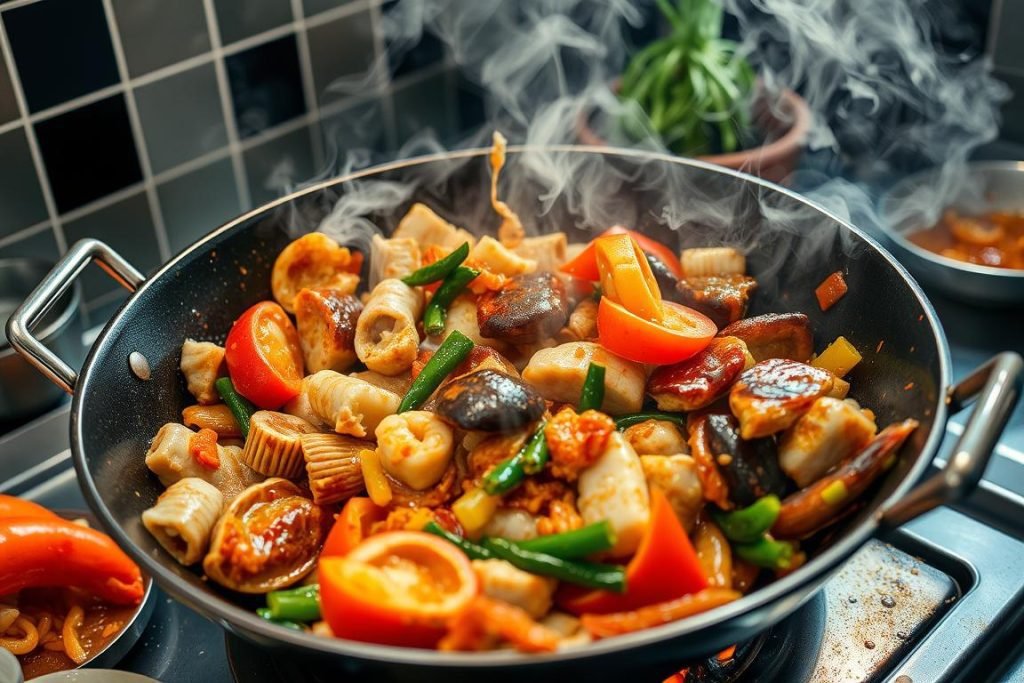
To sear meats right, you need a hot wok. This gets you a crispy outside and a tender inside. It makes your food not just look good but taste good too, keeping all the flavors locked in.
When cooking seafood fast and hot, it stays tender and tasty. Getting shrimp pink or scallops golden is all about technique. The right heat and moves do the trick.
- Preheat your wok until it’s smoking lightly before adding oil to prevent sticking and ensure optimal cooking conditions.
- Utilize oil velveting, a technique where meat is seared in hot oil briefly before stir-frying, to enhance flavor and texture.
- Always pat your proteins dry before they hit the wok to avoid lowering the temperature of the oil, which can interfere with the searing process.
Getting textural nirvana in stir-fry is not just about the proteins. Blanching and pre-cooking meat to about 80% done means everything cooks evenly. This makes every bite of your stir-fry perfect.
Using these tips in your stir-frying makes your meals special. You’re not just cooking, you’re creating memories. It’s about more than heat and marinades. It’s making every meal an adventure in taste and texture.
Wok Versus Skillet: Understanding the Battle for Heat Supremacy
Choosing between a wok or skillet isn’t just about taste. It’s about mastering wok skills for true high-heat dishes. Achieving Wok Hei is key for that genuine flavor.
Wok Hei – The Breath of the Wok
“Wok Hei” means the tasty char smell food gets in a wok. The wok gets very hot, cooking food fast. This locks in more flavor than a regular skillet can.
Material and Shape: Why It Matters
The wok’s shape lets cooks heat food in different ways. Its curved design keeps food in while stirring. Woks are usually made from heat-holding materials like carbon steel.
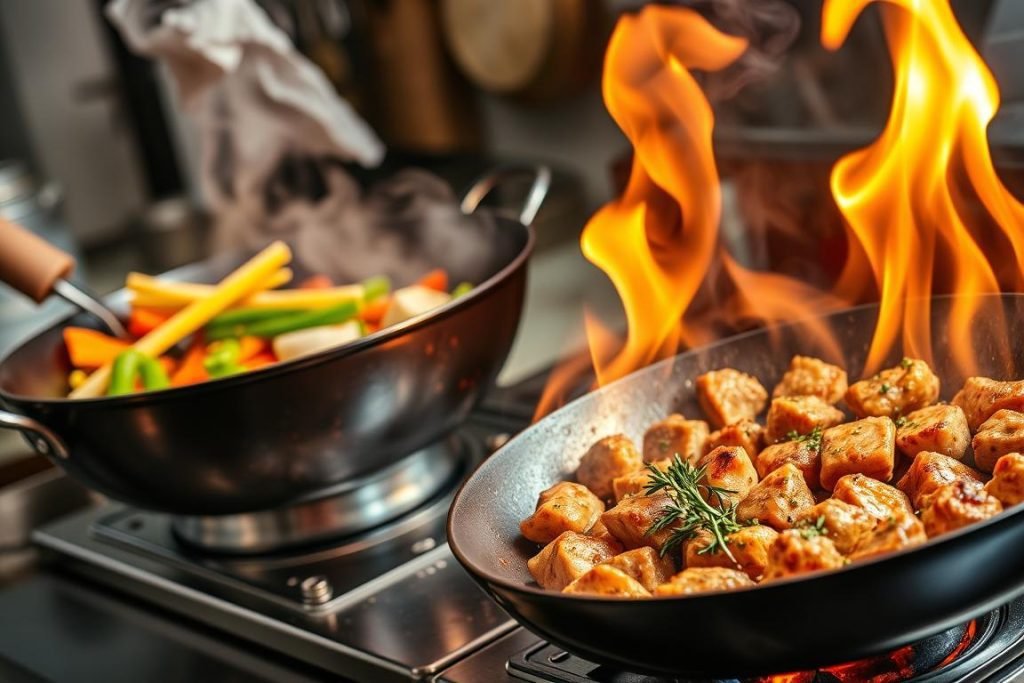
Knowing this helps improve your stir-fry skills. Whether you’re a beginner or expert, choosing a wok matters. It can change the flavor and success of your dish.
Mastering High-Heat Cooking: Tips from the Pros
Beginning to master high-heat cooking starts with knowing the basics well. This is especially true for wok cooking. It’s vital to know how to control heat in a wok. This skill is a must for anyone wanting to make better stir-fries. They’ll taste great and have the perfect texture.
Perfecting the “Hot Wok, Cold Oil” Method
The “hot wok, cold oil” trick is key for good stir-fries. You heat the wok until it’s very hot. Then add cold oil. This way, a non-stick layer forms on the wok. It stops food from sticking and cooks it evenly. Using this method keeps the food’s texture right. It won’t get mushy or too oily.
Navigating the Heat Zones of Stir-Fry
Knowing how to use a wok’s heat zones is a pro skill. It’s about more than just the heat level. It’s about moving food from one part to another. The wok’s center is hottest, perfect for browning meat. Then, move the food to the cooler sides. This stops it from burning.
Here are more tips from the pros for using your wok:
- Preheat the wok well before adding your food.
- Choose oils like peanut or sesame oil that can handle the heat.
- Cook food in batches so each piece gets enough heat.
- Keep stirring and tossing so everything cooks evenly.
With these tips, you’ll cook like a pro. You’ll get the bold tastes and crispy finishes of top-notch stir-fries.

| Cookware Type | Max Temperature | Recommended Use |
|---|---|---|
| Stainless Steel Skillet | 500°F | Alternative to wok for smaller batches |
| Cast-Iron Skillet | 600°F | Good for high-heat searing |
| Titanium Stainless Steel Chef’s Pan | 1050°F | Ideal for professional high-heat cooking |
| Nonstick Cookware | 500°F | Not recommended for high-heat cooking |
With these insights and techniques, you’re ready to master high-heat cooking. You can make amazing stir-fry recipes. Remember, great stir-fry isn’t just about the food. It’s about mastering the heat and timing too.
Marinating Magic: The Secret to Flavor-Infused Proteins
Marinating proteins is key to making delicious stir-fry dishes. It makes every bite flavorful and perfect for quick cooking. This process lets proteins soak up tastes and textures.
By soaking proteins in seasonings, they get ready for the wok. This step is super important for making memorable meals.

Let’s explore how marinating different proteins adds to our meals. Plus, get tips to enhance flavors.
| Protein | Marinating Time | Recommended Marinades |
|---|---|---|
| Chicken | 30 mins – 4 hrs | Soy Sauce, Lemon Juice, Minced Garlic |
| Beef (flank, sirloin) | 2 hrs – 24 hrs | Balsamic Vinegar, Mongolian Fire Oil |
| Pork (chops, loins) | Up to 8 hrs | Pear juice from Korean Bulgogi blend |
| Fish (salmon, cod) | 15 – 30 mins | Simple citrus or char siu sauce |
| Tofu (firm) | Overnight | Thai Satay sauce |
| Vegetables (eggplant, zucchini) | 30 mins – 2 hrs | Nuoc Cham sauce |
| Shrimp | 15 – 30 mins | Garlic, herbs, Citrus blend |
Start your stir-fry by marinating the protein. This adds depth and taste. You can buy or make marinades with soy sauce, garlic, and ginger.
The longer you marinate, the tastier it gets. But, fish and shrimp should not marinate too long. Their flavors are delicate.
Using these marinating tips will make your meals exciting. Your stir-fry will be the star of the table!
Vegetables’ Role in a Balanced Stir-Fry
Veggies are key in healthy stir-fries. They add color, texture, and lots of vitamins and minerals. Learning to pick, ready, and cook them can make your meal from good to great.
Choosing Your Cast of Vegetables
Pick different veggies for a mix of nutrients and looks. Go for staples like broccoli, bell peppers, and carrots. They are chosen for their taste and feel. Each one should feel fresh and firm, showing it can handle the stir-fry heat.
Prep and Cooking Sequence for Best Results
Cut all veggies the same size to cook them evenly. Some, like carrots or broccoli, may need slight blanching. This keeps their crunch. Start cooking with the harder veggies first. Add soft greens later to avoid overcooking them.
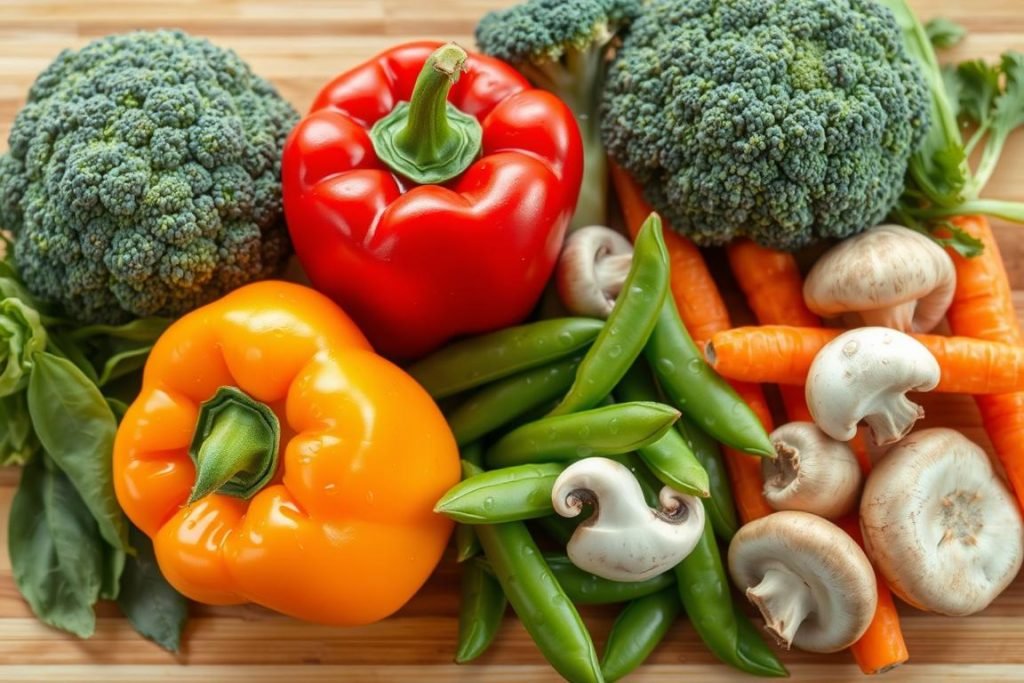
The order and timing in which you add veggies matter a lot. It ensures everything keeps its crunch and nutrients. Doing this improves your stir-fry’s quality.
Adding veggies not only makes your meal healthier. It also boosts flavors. This makes your stir-fries a delight to eat and an important part of weekly meal plans.
Crafting the Quintessential Stir-Fry Sauce
To master Asian cuisine, it’s key to know how to make a great stir-fry sauce. This sauce boosts flavor in your fast cooking recipes. It makes every dish taste authentic and delicious.
Base Ingredients for Flavor Depth
Great stir-fry sauce starts with some basic ingredients. Soy sauce adds a strong umami flavor. Oyster sauce brings a mix of sweet and salty tastes. Sesame oil gives a bit of nuttiness, and honey makes it sweet. These ingredients work together to form a perfect base.
Customizing the Spice and Sweetness
Adjusting the spice and sweetness makes the sauce your own. Chili oil or sriracha adds heat. Use tamari or coconut aminos for less salt and no gluten. This way, you can make a sauce that fits your taste and health needs.
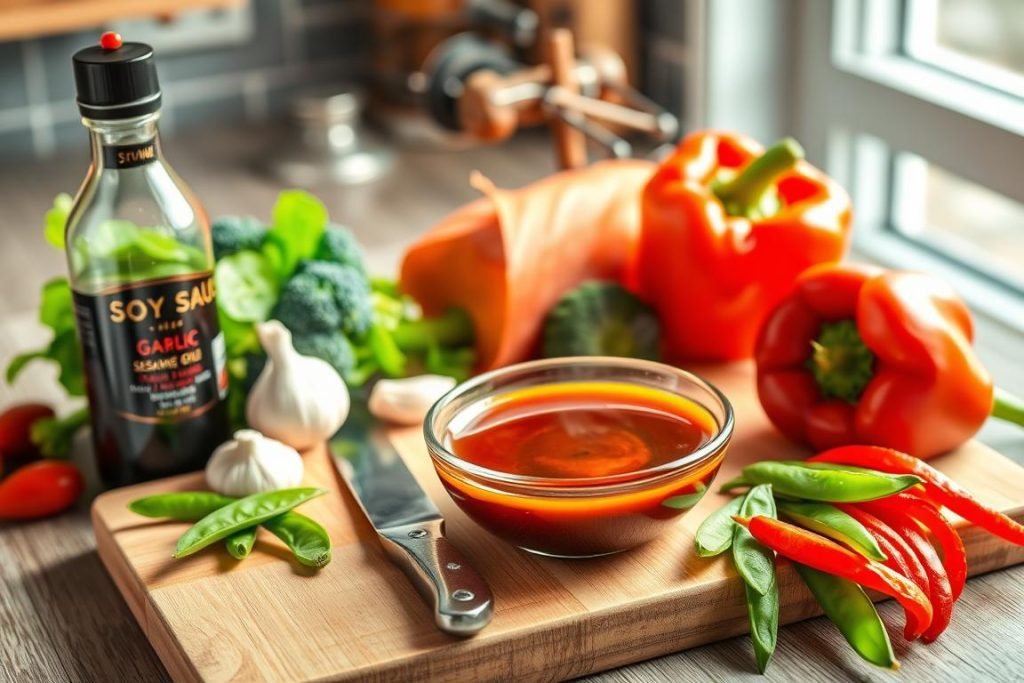
Here’s a quick guide to balance your stir-fry sauce. This will help you keep your dishes tasty and versatile. It adds that special Asian cuisine flavor.
| Ingredient | Flavor Profile | Role in Sauce |
|---|---|---|
| Soy Sauce | Umami, salty | Base flavor enhancer |
| Oyster Sauce | Sweet, salty | Adds depth and richness |
| Sesame Oil | Nutty, aromatic | Provides a distinct aroma |
| Honey | Sweet | Balances overall flavors |
| Chili Oil/Sriracha | Spicy | Enhances heat level |
| Tamari/Coconut Aminos | Umami, less salty | Substitute for soy sauce (gluten-free) |
With these tips, you’re ready to make a sauce that boosts your dishes. The best sauce matches your own taste!
Serving and Savoring: Beyond the Wok
After you learn how to make healthy stir-fries, the next step is fun. You turn these dishes into full, tasty, and healthy meals. It’s not just about putting food on a plate. It’s about adding the right sides and making every bite perfect.
Pairing Stir-Fries with Sides and Toppings
Choosing good sides makes your stir-fry a full meal. For those watching their carbs, zoodles or cauliflower rice are great. They keep meals low in carbs and full of taste. Others might like steamed rice or noodles. They soak up the stir-fry sauce well. To make it tastier, add toasted sesame seeds or some chili oil.
Nutritional Benefits of a Veggie-Packed Plate
A stir-fry full of veggies is very healthy. These meals are low in calories but rich in vitamins and minerals. Stir-fries can be made with different ingredients to meet your health needs. They are great for a healthy diet.
Table: Comprehensive Nutritional Chart for a Typical Vegetable Stir-Fry Serving
| Nutrient | Amount |
|---|---|
| Calories | 311 kcal |
| Protein | 26g |
| Carbohydrates | 9g |
| Fat | 18g |
| Saturated Fat | 3g |
| Polyunsaturated Fat | 4g |
| Monounsaturated Fat | 10g |
| Cholesterol | 68mg |
| Sodium | 550mg |
| Potassium | 524mg |
| Fiber | 1g |
| Sugar | 4g |
| Vitamin A | 122IU |
| Vitamin C | 7mg |
| Calcium | 51mg |
| Iron | 2mg |

Conclusion
Stir-Frying Meat and Seafood is not only about cooking. It’s a trip into culture and deliciousness. Using a wok and balancing flavors show a deep history. They reflect traditions from Cantonese, Szechwan, Beijing, to Fujian areas.
When we stir-fry, our choices affect taste and health. Asian cooking mixes five key flavors. This mix leads to healthy stir-fries that are tasty and good for us. The key is using the best ingredients, fresh or frozen.
Stir-frying combines old traditions with new methods. It makes dishes full of flavor and color. Whether in a cast iron skillet or a wok, every dish tells a story. Remember, as you cook, you’re part of a great food heritage.